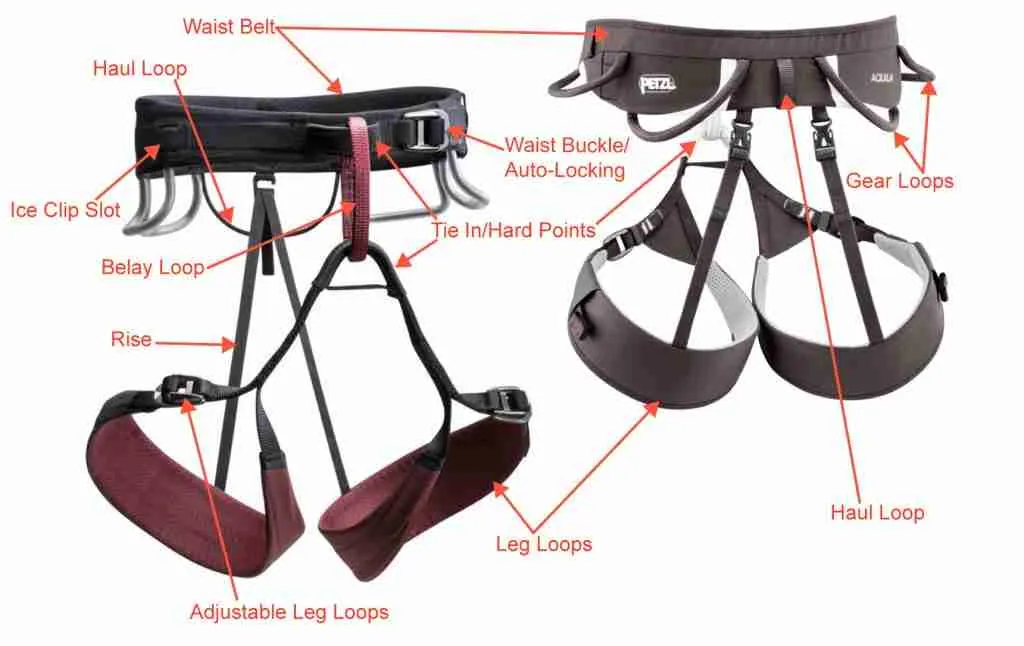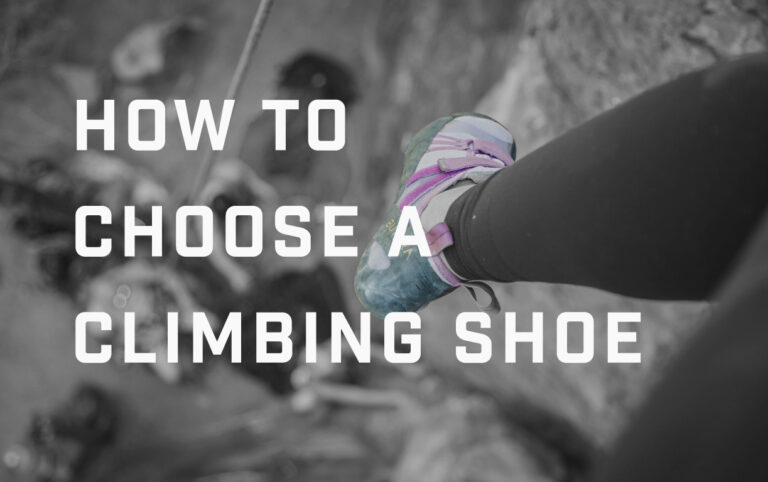- How To Choose A Climbing Harness That’s Best For You
- How To Size A Climbing Harness
- Men’s vs Women’s Climbing Harness
- Different Types Of Climbing Harnesses
- Parts Of A Climbing Harness
- What Is A Climbing Harnesses Made Of
- How Strong Is A Climbing Harness
- A Brief History Of Climbing Harnesses
- Putting It All Together To Help You Choose A Harness
- Summary
Have you been bitten by the climbing bug?
Maybe you’re a long time climber looking to upgrade your gear?
If so, you might be wondering how to choose a climbing harness that fits just right.
As with most things, making good decisions is easier when you are informed.
The following article will give you all information, big and small, that you need to choose the best climbing harness for your needs.
How do you choose a climbing harness that is best for you, that suits your needs, is comfortable, and that will last?
We’ve got your answer!
Read on to get informed, to get the perfect harness, and to climb comfy and confident.
If you want some quick picks, check out our guide to the best climbing harnesses of 2022.
How To Choose A Climbing Harness That’s Best For You
Similar to buying a car or a new computer, if you don’t know what you are looking for when choosing a harness, you might end up with a case of buyer’s remorse.
Choosing the right piece of gear in any situation requires a bit of understanding.
So after the basics of fit, we give you some quick background about harnesses, their components, different types, and what to look for when buying.
Use the table of contents above for quick navigation.
For a quick pick, here are our favorite all-around harnesses (all listed harnesses available in both men’s and women’s sizes)
How To Size A Climbing Harness
In general, you want to follow two simple rules when sizing your harness:
- Snug but not tight
- A minimum of 5 finger-widths of tail left on all straps once buckled.
Most people will quote you 3 finger widths, but I feel 5 should be the minimum.
When you try on a harness you probably aren’t wearing layers, and as you wear a harness throughout the day the buckle will loosen a bit.
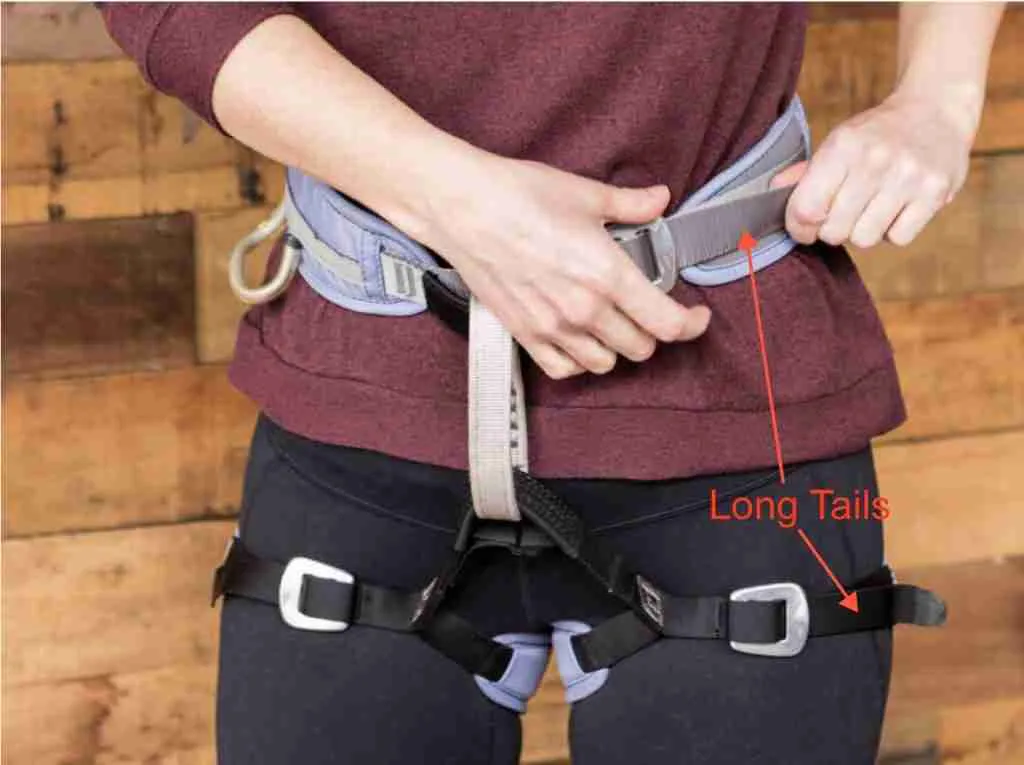
Too little tail on your waist belt or leg loops can be dangerous.
It is possible for the belt to slip with normal usage or when loaded like when you take a big whipper or spend most of the day at a hanging belay.
Why risk it? Get a harness that fits.
The key aspects of a well fitted harness are:
- Sits comfortably-snug just above your hip bones.
- Small enough that you can cinch it down snug without running out of belt, but large enough that you don’t have to cinch it tight to have a safe amount of left-over waist belt or ‘tail’.
- Once secured, you should not be able to pull it down over your hips.
- Leg loops should be just snug enough to slip a hand between your leg and the loop.

Sizes
Almost all harnesses come in standard sizes from XS-XXL.
If trying on multiple harnesses from different companies’ proportions may vary, but once you know your size in one brand it usually stays the same for that brand’s different models.
In the example below, you can see Black Diamond’s sizes are slightly bigger than Mammut’s.
When buying online, be sure to know your size ahead of time or stop in a shop to try on the brand you are looking at to ensure you get the right size.

Test It First If You Can
Many stores will have a rope where you can clip in and hang in the harness you are trying on. Take advantage of this, noticing areas that may pinch or press in the wrong way. Watch for any pressure points or hot spots.
Whether you an experienced multi-pitch climber or just beginning, you are going to spend a lot of time hanging in your harness. Make sure it’s comfortable from the start.
Men’s vs Women’s Climbing Harness
In terms of load-bearing design, there is essentially no difference between men’s and women’s harness.
Both undergo the same safety tests and are rated to the same forces.
The difference is seen in fit.
A women’s harness will tend to ride a bit higher on the waist and have proportionally larger leg loops.
There is no reason a man could not wear a woman’s harness or a woman wear a man’s. What really matters is fit.
Personally, I always try on both the men’s and women’s of a harness I am thinking of buying.
On more than one occasion the women’s has fit me better than a men’s harness.
Different Types Of Climbing Harnesses
Climbing harnesses can be divided into a few main categories: gym climbing, sport climbing, trad/traditional climbing, mountaineering or alpine.
There are also some categories worth mentioning that fall in-between: full-body harnesses, caving and canyoneering, and of course industrial-work harnesses.
In terms of functionality, there is a lot of overlap, meaning a sport harness could work for mountaineering the same way a traditional harness can be just fine for the gym.
For most climbers, the harness you choose will come down to weight and functionality, or what type of climbing you do most.
Let’s see what each category can do for you.
Gym Climbing Harnesses
- Minimalist and lightweight
- Limited gear loops
- Non-adjustable leg loops
When climbing in the gym you don’t need to carry gear or extra layers and you aren’t going to be hanging at a belay all day either.
Gym harnesses forgo the extra weight of burly gear loops and padding to give you the lightest-sleekest harness to help you pull hard when every gram counts.
The BD Airnet is probably the best example of a purely gym or light-sport climbing harness.
Its a bit on the pricey side, but if you go for it you will not be disappointed.
BD Airnet
An ultralight-minimalist harness that’s still comfortable and rugged. The Airnet is about as slim as you’ll get for a gym or light-sport climbing harness.
• Only 235g
• 2 front gear loops-webbing back loops
• Patented airNET technology for comfort under pressure
• Infinity belay loop
• Non-adjustable leg loops

Or, if you want something light, affordable, and simple the Black Diamond Solution is a solid all-around harness for the gym and the crag.
Black Diamond Solution
Light, comfortable, and with everything you need and nothing you don’t. Perfect intro harness or gym to crag harness.
• 330g
• 4 gear loops
• No haul loop
• Non-adjustable leg loops

Sport Climbing Harnesses
- Lightweight
- More padding
- May have adjustable leg loops
Sport climbing harnesses will have more gear loops than a pure gym harness and may be slightly heavier due to added padding for comfort.
A sport harness will usually have fixed leg loops but can feature adjustable leg loops as well.
When getting a sport climbing harness over a gym harness, look for lighter weight and more options like gear loops or ice-clip loops and perhaps a bit more padding or width in the waist belt.
Arc’teryx AR-395a
Arc’teryx is relatively new to the harness game, but the AR-395a is one of the most comfortable sport to all-around harnesses at a great price.
• 395g
• 4 gear loops
• WST technology with 4-way stretch
• Adjustable leg loops

Or an even lighter harness designed specifically with sport climbing in mind:
Black Diamond Zone
The Zone is the lighter more skilled version of the Solution harness. Featuring BD’s patented Fusion Comfort Construction the Zone’s wasit belt has 3 horizonal pieces of webbing to distribute load throughout the waistbelt; making for a more comfortable harness over all.
• 307g
• 4 gear loops
• Ice-clip slots
• Non-adjustable leg loops

Trad/Traditional Climbing Harnesses
- More back support for hang time
- Increased padding
- Spacious & durable gear loops
- Adjustable leg loops
The main difference when you step up to a trad oriented harness is the padding and gear loops.
When trad climbing you are likely to be doing multi-pitch climbs spending more time in your harness and/or hanging in your harness for longer.
As a result, these harnesses usually opt for more padding (and/or a greater width) in the waist belt and leg loops with a wider profile for support.
Gear loops will usually be larger to accommodate the increased amount of gear needed for trad climbing.
And almost all traditional oriented harnesses will have adjustable leg loops to accommodate layers when climbing in cooler temperatures.
One of the most affordable, comfortable, and multi-pitch ready harnesses out there is the Mammut Ophir.
Mammut Ophir 3
The Ophir is a great trad harness with ample gear loops and split-webbing technology to keep you comfortable at all those hanging belays.
• 350g
• 4 gear loops
• Belay loop wear indicator
• Split webbing technology

And maybe one of the most well thought out-comfortable trad to all-around harnesses ever made; the Petzl Aquila.
Petzl Aquila
The Aquila is ready for anything. A wide waist belt with a slim contoured front makes it comfortable to sit in while offerering freedom of movement on the way up. Extra-large gear loops, polyethylene hardpoints, and quick-adjust locking waistbelt.
• 360g
• 4 XL gear loops
• Contoured waist belt
• Split webbing technology
• Adjustable leg loops

Alpine or Mountaineering Harnesses
Often used interchangeably, the differences between alpine climbing and mountaineering are subtle but important.
Mountaineering involves snow, ice, and some form of climbing but may not necessarily reach a summit.
Mountaineering as a term has more to do with mountain travel than climbing.
In this case, simply crossing glaciers and post-holing over a ridge, you may see a very basic harness like this classic BD Bod harness being used:

Whereas alpine climbing, possibly considered a sub-set of mountaineering, is more about climbing a mountain with the goal of reaching the summit.
Regardless, harnesses for these types of climbing tend to be light, adjustable and have lots of gear storage options.
What might be considered an alpine or mountaineering harness will also have loops for ice-clips.
Two of the best alpine oriented harnesses currently on the market; the Arc’teryx AR-395a and the Black Diamond Vision.
Arc’teryx AR-395a
The AR-395A performs well in any condition but excels in the rugged. With stretch technology, large gear loops, ample ice clip slots all in a comfortable ride, the AR-395A will take you to the summit and back in style.
• 395g
• 4 large gear loops
• WST tech wasit belt
• 4 ice clip slots
• Adjustable leg loops

Black Diamond Vision
One of the lightest alpine oriented harnesses ever made, BD have out done even their own history of high level performance with the Vision harness. Maybe not the most comfortable for long hanging belays. But if you are counting every ounce for your next fast-light ascent, this harness helps you achieve your vision.
• 224g
• 5 gear loops
• Quick dry material
• 4 ice clip slots
• Adjustable leg loops
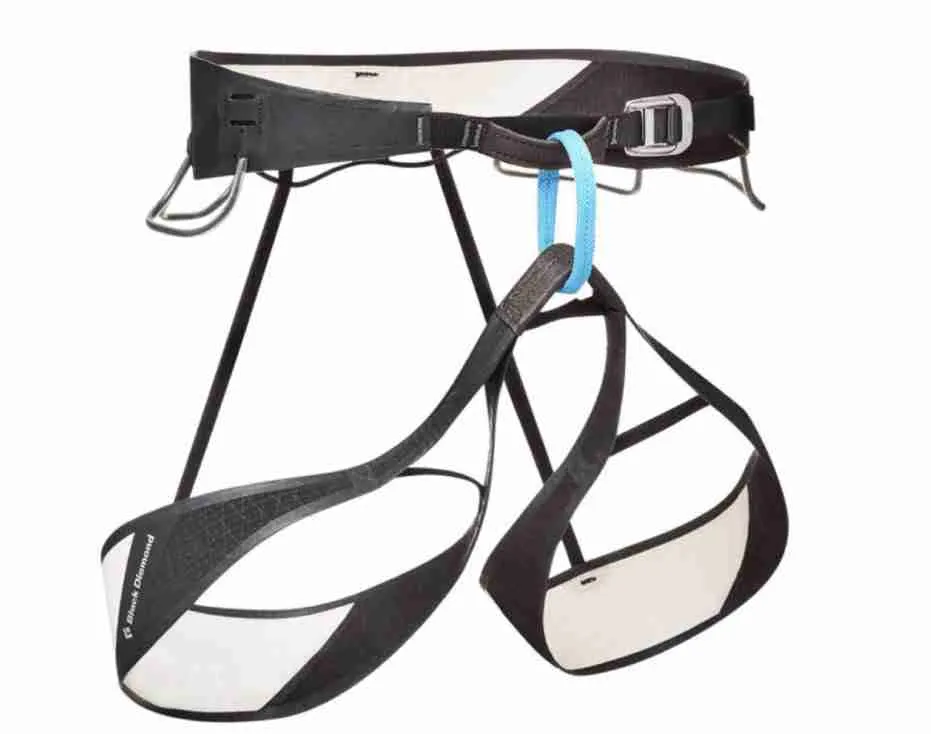
Remember, any UIAA certified lead harness can be used for whatever type of climbing you are doing.
What is important is to find the one that suits your type of climbing most.
Parts Of A Climbing Harness
Ok, now you’re convinced they’re strong.
But before we dive into harness features that might impact your purchasing decision, let’s get familiar with the actual parts of a harness so we know what to look for.
Waist Belt
Perhaps the most important part of a climbing harness and certainly the beefiest part, the waist belt wraps around your waist forming the main upper-portion of a harness.
Waist belts are made of webbing partially covered by nylon and foam. A standard harness waist belt will consist of a tie-in loop, a buckle, and belay loops.
Waist Buckle
The majority of modern harnesses have auto-locking waist buckles (as seen in the diagram above).
Previously the buckle would come completely free of the webbing in the same way a standard clothing belt might. In that case you had to manually ‘double-back’ your harness buckle.
For safety, the majority of new harnesses feature an integrated auto-double-back sliding buckle with offset feeds that does this for you when cinched tight (i.e. it is always doubled back).

Regardless of the type of buckle on your harness, always ensure that your buckles are doubled back before climbing.
Leg Loops
As the name implies, two leg loops wrap around each leg. Usually made of the same material as the waist belt webbing, these loops connect at the front in the middle with a tie in point; also called a hardpoint.
Leg tie in points will usually have a thin crossbar at the apex to help keep the rope in place.
Leg loops can be adjustable in size or fixed. More on that later.
The Rise
The distance between your leg loops and your waist belt is called the rise.
Between the leg loops and the back of your harness, you will find two thin, often elastic, bands.
These bands are usually adjustable and attach the leg loops to your waist belt.
Adjusting the rise will change the way you sit in the harness and fiddling with this distance can dramatically change the way a harness feels when on.
The elastic bands connecting your leg loops and waist belt are NOT load-bearing in any way.
Tie-in Loops
Often referred to as ‘hardpoints,’ your harness has two tie-in loops. When you tie into a climbing rope you will feed it through both of these hardpoints.
The waist belt has an extra thick portion that loops out from the main belt. This hardpoint is where you feed the rope through when tying into its end.
Climbing harness leg loops are linked together by a thicker middle part that forms a loop with a thin-non-weight bearing cross piece connecting them (this helps keep your rope in place when tied in).
The thicker upper loop is weight-bearing and is the second hardpoint you will use to tie in.
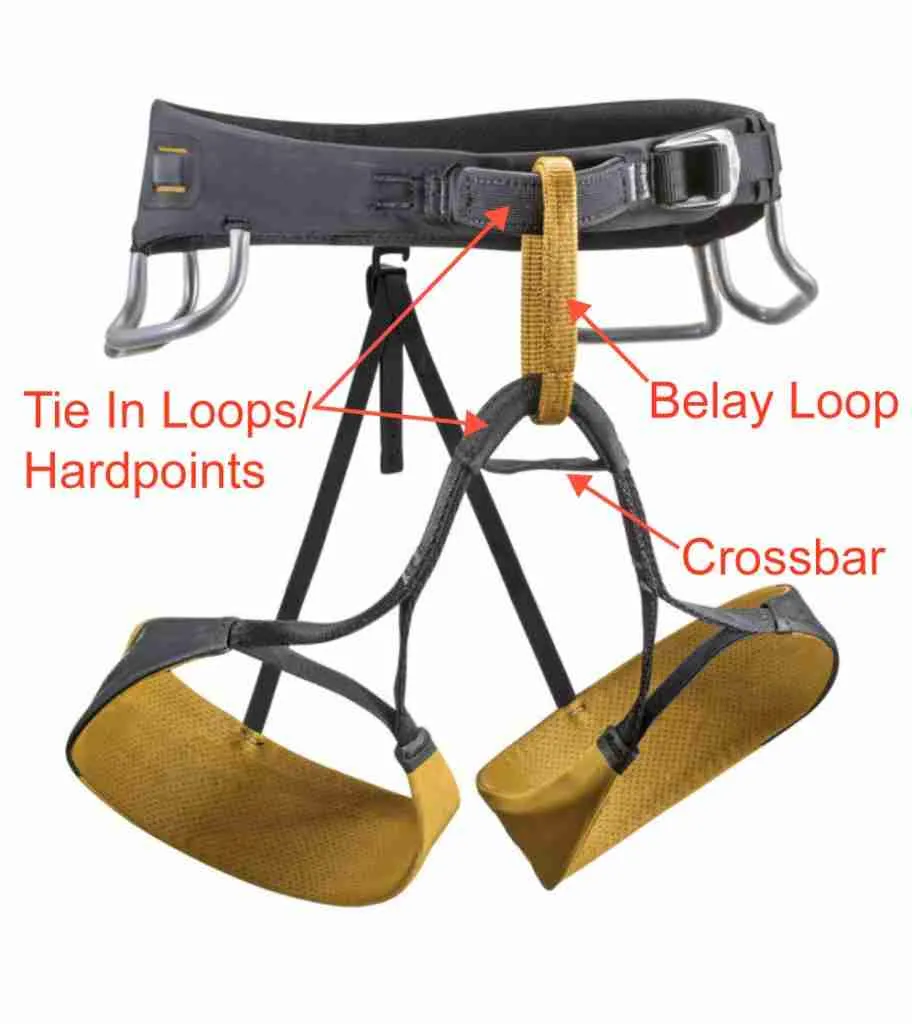
Belay Loop
The belay loop is the circular piece of thick webbing connecting to the two hardpoints discussed above. Or more simply, the belay loop connects the waist belt to the leg loops.
Aptly named, the belay loop is where you attach your belay device when belaying a climber or rappelling.
The belay loop is the strongest point of a climbing harness. As noted, it must hold at least 15 kN to be certified for use.
Haul Loop
Not to be confused with a belay loop, haul loops are NOT intended to be load-bearing. DO NOT use a haul loop in the same way as a belay loop or hardpoints.
Haul loops are usually located at the center back of your harness. They are intended for ‘hauling’ up an extra line or clipping on things like extra shoes or small packs.
Haul loops can be small sewn pieces of webbing or larger loops that resemble gear loops on the side of the harness.

A haul loop is usually stronger than a gear loop so it is a safer place to clip your extra jacket or water bottle.
But again, a haul loop is NOT a load-bearing part of a climbing harness.
Gear Loops
Depending on the type of harness you get (see below), it may have more or fewer gear loops.
The standard is 4, although ultra-light gym harnesses may have only 2 gear loops.
Gear loops can be made of webbing, cord, plastic, or a combination of the two. They are where you clip carabiners and other gear while climbing; like little coat hangers attached to the side of your harness.
While they are fairly strong, gear loops are one of the weakest parts of a harness.
And similar to a haul loop, they are NOT intended to be load-bearing.
What Is A Climbing Harnesses Made Of
As we mentioned before, the invention and subsequent widespread use of nylon found its way into climbing almost immediately.
Early swami belts were made of nylon webbing. Modern climbing harnesses are usually made of nylon and polyester and foam.
While today’s harnesses may use other materials to provide comfort and gear storage, nylon still creates the backbone of harnesses that makes them so strong.
Nylon, specifically nylon 6, is one of the strongest-stretchy fabrics on earth and is the same material that dynamic climbing ropes are made from.
How Strong Is A Climbing Harness
Just how strong is this nylon stuff?
It’s strong, really strong.
Harness sold in North America and Europe will have a safety standard code printed on them.
For harnesses this is CE 0082 and/or UIAA-105 and/or EN-12277.

To be CE/UIAA certified (never buy one that is not) a climbing harness must meet certain minimum strength requirements.
The European Economic Committee (CE) is responsible for setting standards for goods entering Europe.
All gear sold in Europe must meet their minimum standards. CE 0082 is the standard a harness must meet.
Interestingly, this is not a requirement for sales in North America but all reputable manufacturers still meet these standards.
While the CE enforces these standards, the UIAA is responsible for creating them. The diagram below shows the UIAA test standards for climbing harnesses.
If you want more detail, you can learn more about these certifications and governing bodies in regards to climbing gear here.
A harness’s belay loop must withstand at least 15 kN of force before breakage. And its waist belt must withstand 10 kN of force before breaking.
Most companies, as you can see towards the end of the video below (minute 8:45), aim to exceed these minimums.
For reference, a kN or Kilonewton is a measure of force and 1 kN is roughly equivalent to 223 lbs of force.
That means 15 kN, the minimum passing strength for a belay loop, is about 3372 pounds of force.
You could probably haul your car up the cliff attached to your harness if you had the right pulley system!
So how strong is a climbing harness? Really, really strong.
That said, while nylon is an extremely durable material, your harness must be cared for properly and retired when appropriate (learn more here).
A Brief History Of Climbing Harnesses
The invention of the harness as a climbing safety device is largely credited to a Dutch climber from the late nineteenth century named Jeanne Immink.
Known for her bold climbing and thwarting of nineteenth-century social conventions (she was the first woman to wear pants instead of a dress climbing), Immink was one of the earliest documented climbing junkies.
The harnesses of Immink’s time likely didn’t much resemble the ‘sit’ harnesses used today.
Well after her debut, some of the first climbing harnesses to resemble those of today were invented by three U.K. guys who went on to form a company called Troll.
The greatest climbing company you’ve never heard of, Troll is not only responsible for the first modern harnesses but also some of the first climbing nuts, descenders, and slings.

Around the same time, climbers in Yosemite were adapting swami belts (knotted and looped webbing harnesses) for more versatility and comfort.
Soon stitching replaced the knots and the modern ‘seat’ harness used today was born.
Putting It All Together To Help You Choose A Harness
Moral of the story, familiarize yourself with the parts of a harness and choose one that is comfortable and has the components you need.
What Type Of Climbing Do You Do Most?
One of the easiest ways to choose a harness is to figure out what type of climbing you will be doing most often.
If you mostly crack climb and like doing mountain routes or big walls, then you probably want a harness with lots of padding, ample gear loops, and adjustable leg loops.
The Petzl Adjama or Aquila would both be a great choices.
However, if you solely climb in the gym a minimalist harness with limited gear loops and little to no padding will suit you just fine.
The BD Airnet is a sleek-comfy example of this type of climbing harness.
Now, if you do it all—sport climbing, gym climbing, multi-pitch—get a harnesses that gives you the most options at the lowest weight.
Look for something with a decent amount of waist belt padding or suspension technology and larger gear loops.
You don’t have to get adjustable leg loops if you don’t think you’ll be climbing in cold weather.
Two amazing all-around harnesses are the Petzl Aquila and the Black Diamond Zone.
Another option is getting two harnesses. If you mostly train in the gym but get out for the occasional day trip or destination climbing trip, get an inexpensive lightweight harness for the gym and a more durable-versatile harness for outdoors.
A good combination might be the Black Diamond Solution for affordability, and the Arc’teryx AR-395a for all-around awesomeness.
Summary
Your climbing harness is a critical piece of rock climbing gear. Choosing the right harness can seem a bit daunting at first but break it down to what you truly need it for and choosing a harness you will actually like is simple.
Here are a few key questions to help you hone in on the right one:
- Do you prefer light-weight or more comfort?
- Do you need more or less gear loops?
- Will you be climbing in cold weather or looking to use your harness ice climbing?
At the least, a well fitted harness will meet these requirements:
- Sits comfortably-snug just above your hip bones.
- Small enough that you can cinch it down snug without running out of belt, but large enough that you don’t have to cinch it tight to have a safe amount of left-over waist belt or ‘tail’.
- Once secured, you should not be able to pull it down over your hips.
- Leg loops should be just snug enough to slip a hand between your leg and the loop.
You can decide on an activity-specific harness for gym climbing or a more comfortable harness for sport cragging. Or opt for an all arounder for trad and multi-pitch.
Regardless, almost all CE/UIAA harnesses are rated to the same safety standards. A lightweight UIAA lead climbing harness is just as strong as a heavier more adjustable one (always check manufacturer specifications before purchase and use).
Once you’ve found that perfect harness, read this article to learn how long it should last and how to keep it clean and strong in the long run.
Like a car, they all help get you safely to the top. What type of harness you choose will depend on the type of journey you take to the summit.
In the words of that creepy old knight from Indiana Jones and The Last Crusade, “You must choose, but choose wisely.”
What harness did you decide on?


